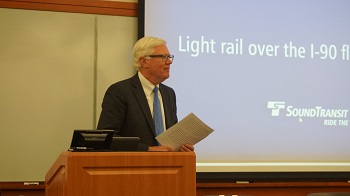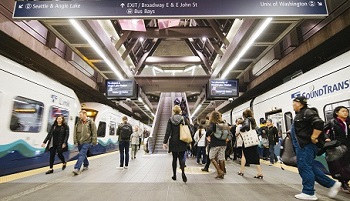Mike Harbour (BE’75) started his career in public transit in Nashville, working for the MTA for a year after he finished his graduate studies in transportation.
He’s back this week as a guest of the Nashville Chamber of Commerce, which has organized a series of discussions and panels with transit experts who’ve navigated growing pains in Seattle, Washington.
Harbour is deputy chief executive of Sound Transit, which builds and operates a popular, expanding light rail system in Seattle’s three-county metropolitan area. He joined Sound Transit in 2012 after 17 years in Olympia, Wash., and other transit management posts in New Orleans, Orlando, and Savannah.
On Monday, he was at the School of Engineering to talk about the challenges of building a transportation system in a developed region. Harbour also talked a bit about his education at Vanderbilt and how it helped shape his career.

A native of Mobile, Alabama, Harbour knew he wanted to be an engineer but also knew he wanted a broader liberal arts education. That’s why he picked Vanderbilt.
“I don’t think I could have been at a better place,” he said.
In addition to courses for a civil engineering major, Harbour took classes on urban economics, planning and housing. In building public transportation systems, he said, “You don’t just deal with technical problems. You deal with other problems that are often harder than the technical problems.”
As an undergraduate, Harbour volunteered with a housing advocacy group in Nashville but realized quickly transportation was, for him, a more viable career option than affordable housing. A self-described “very task-oriented individual,” Harbour had a keen interest in how cities worked and developed. He still does.
With the upcoming $5.4 billion transit referendum, he said, Nashville faces the same question Seattle did decades ago – does it want to be an automobile-oriented city or does it want to provide options that allow residents to make different choices?
In the 1970s, Seattle voters said “no” to two transit proposals. By the 1990s, sentiment had changed. Voters in 1996 approved a $3.9 billion plan that included a light rail line, commuter rail, express bus routes, transit centers, and park and ride lots. In 2008 they passed a $17.9 billion extension that added 36 miles of light rail (for a total of 55 miles), plus commuter rail and express bus enhancements. In 2016, a $54 billion plan cleared voters and will add 62 more miles of light rail and expanded rapid bus transit and commuter rail lines.

Sound Transit, with 1,000 employees, now is steward of the largest capital public transit program in the country. The region itself has embraced rail and connecting options – ridership is growing at some of the fastest rates in the country and fewer people are driving downtown for work – despite huge increases in the number of jobs there.
Among the lessons learned:
- Light rail needs a strong bus system to support it.
- People want choice and reliability – and reliability, in terms of knowing how long a trip will take, is probably more important than speed.
- People will ride light rail who will never ride a bus.
- Transit won’t solve the congestion issue. No one has ever solved the congestion issue.
Robust public transit is about lifestyle and options that connect people with housing and employment, Harbour said. “It is an important social and economic lifeline.”
“It is a choice the community has to make,” he said. “It depends on what you want your community to be.”